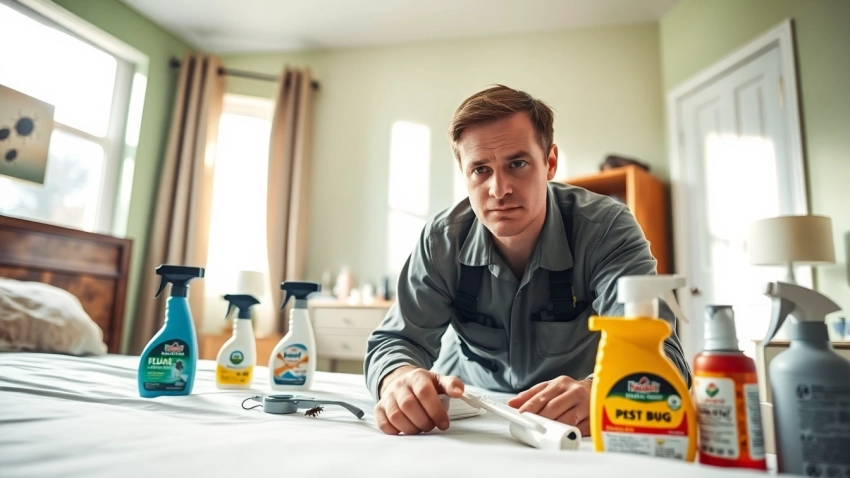
Effective Methods for Bed Bug Treatment: Strategies and Best Practices
Understanding Bed Bugs
What Are Bed Bugs?
Bed bugs are small, flat, reddish-brown insects belonging to the Cimex lectularius species. They are parasitic creatures primarily known for infesting human habitats, where they feed on blood, often causing itchy welts on the skin. Adults can grow up to 5-7 mm in length, resembling apple seeds, while their eggs are about the size of a grain of rice—tiny and almost translucent. One of the most alarming aspects of bed bugs is their ability to reproduce rapidly; a single female can lay hundreds of eggs in her lifetime, which exacerbates the problem once an infestation is established.
Signs of Infestation
Identifying a bed bug problem early can be crucial in managing an infestation. Key indicators include:
- Blood stains: Small red or brown stains on sheets or mattress that may indicate bed bugs have been crushed.
- Bed bug feces: Dark, tiny spots on bedding, walls, or furniture where the insects have excreted.
- Eggs and skins: Small, white eggs, and shed skins from their growth process may be found in crevices.
- Live bugs: Adult bed bugs can sometimes be spotted in the seams of mattresses or behind headboards, often hiding during the day and coming out at night.
The Life Cycle of Bed Bugs
The life cycle of bed bugs consists of five nymph stages before reaching adulthood. The developmental stage from egg to adult can take as little as a month under favorable conditions.
- Egg: Eggs hatch in about 6-10 days into nymphs.
- Nymph: Nymphs molt five times, requiring a blood meal at each stage to progress, taking about 2-3 months to become adults.
- Adult: Reproduces, with females capable of laying 200-500 eggs in a lifespan, which can last up to a year without feeding.
Preparing for Bed Bug Treatment
Initial Steps for Homeowners
Before embarking on any bed bug treatment, homeowners should take preliminary steps to assess and prepare their space. This includes:
- Conducting a thorough inspection of all rooms, focusing on bedrooms, living areas, and furniture.
- Decluttering and removing items that are infested, giving preference to disposal over relocation to decrease risk.
- Reporting any signs of infestation to all household members or guests promptly.
Essential Items for Treatment
Homeowners need to gather several essential items before beginning treatment:
- Protective gear: Gloves, masks, and goggles to prevent exposure to chemicals or allergens.
- Vacuum: A vacuum cleaner with strong suction and a crevice tool effective for cleaning carpets, baseboards, and upholstered furniture.
- Plastic bags: For sealing contaminated items and preventing bed bugs from escaping during transport.
- Bed bug encasements: Special covers for mattresses and box springs to trap bed bugs and prevent new infestations.
How to Clear Infested Areas
To successfully clear infested areas, consider the following actions:
- Remove bed linens, pillowcases, and comforters. Wash them in hot water and dry on high heat for at least 30 minutes.
- Vacuum upholstered furniture, curtains, and surrounding areas thoroughly, paying close attention to seams and crevices.
- Seal all cracks and crevices in floors, walls, and furniture where bed bugs may hide or travel.
Types of Bed Bug Treatments
Chemical Treatments Overview
Chemical treatments involve using pesticides specifically formulated to target bed bugs. These products can be effective, but a strategic approach is essential to ensure thorough coverage and minimize risks. Pesticide methods typically fall under two categories:
- Residual insecticides: These chemicals remain effective for weeks or months, providing ongoing protection against new bed bugs.
- Insect growth regulators (IGRs): These prevent nymphs from developing into adults, thereby breaking the infestation cycle.
Heat Treatments Explained
Heat treatment is another effective solution, where the temperature of a room is raised to between 120°F to 140°F (49°C – 60°C) for a sustained period. This temperature is lethal to all life stages of bed bugs. In addition to being chemical-free and environmentally friendly, heat treatments can:
- Effectively kill bed bugs hidden deep within furniture and wall voids.
- Lower the risk of re-infestation as there are no harmful chemical residues left behind.
Natural Remedies for Bed Bug Treatment
For those inclined toward natural approaches, several methods can be deployed, though they may be less effective than professional treatments. Common natural solutions include:
- Essential oils: Oils such as tea tree oil, lavender, and peppermint can repel bed bugs when used properly.
- Diatomaceous earth: This natural powder can dehydrate bed bugs if they come into contact with it.
- Steam cleaning: High-temperature steam can kill bed bugs on contact and is effective on affected furniture and bedding.
Executing Your Bed Bug Treatment Plan
Step-by-Step Instructions for Chemical Treatments
When using chemical treatments, adherence to guidelines is essential:
- Read and follow all label instructions to ensure safety and effectiveness.
- Apply insecticides in cracks, crevices, and other harborages to ensure comprehensive coverage.
- Monitor treated areas intermittently to ensure the effectiveness of the application.
Implementing Heat Treatment Safely
For effective heat treatment:
- Remove heat-sensitive items, such as electronics and plants, from the area being treated.
- Utilize specialized commercial heating equipment or hire professionals experienced in heat treatments.
- Monitor temperature continuously to ensure it remains within the target range for the necessary duration.
Monitoring Progress Post-Treatment
After implementing treatments, monitoring the situation is vital for success:
- Regularly inspect for signs of bed bugs and continue to vacuum and declutter to minimize hiding spots.
- Consider using bed bug traps or monitors to capture and identify any lingering bugs.
- Continue using mattress encasements and regularly wash bedding to help prevent re-infestation.
Preventing Future Infestations
Best Practices for Home Maintenance
The best way to avoid dealing with bed bugs is to practice proactive home maintenance:
- Maintain cleanliness in all areas of the home, especially in bedrooms and living rooms.
- Regularly wash and dry bedding and clean your home to remove any potential remnants or eggs.
- Carefully inspect items brought in from outside, such as bags and furniture.
When to Seek Professional Help
If an infestation persists despite your efforts, it may be time to enlist professional pest control services. Signs that professional help may be necessary include:
- Persistence of bites or sightings even after treatment.
- Finding bed bugs in multiple locations within the home.
- The challenge of treating a large or heavily infested area without specialized resources.
Long-term Strategies for Bed Bug Prevention
To maintain a bed bug-free environment, consider these long-term strategies:
- Regularly monitor living spaces for signs of bed bugs, especially after travel.
- Invest in quality mattress and box spring encasements to trap bed bugs and minimize their ability to infest.
- Educate household members on bed bug prevention strategies, ensuring everyone knows how to spot signs and respond appropriately.












Leave a Reply